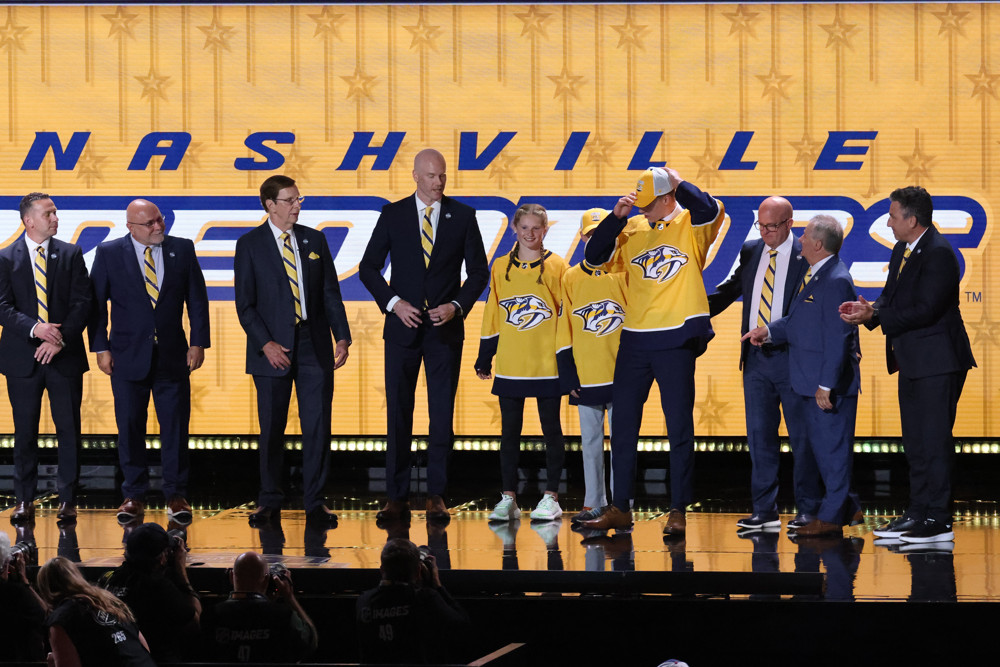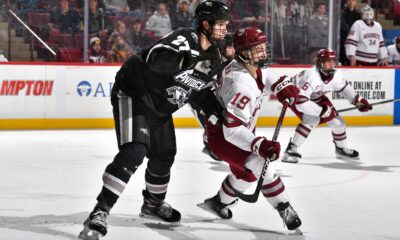A few weeks before the 2023 NHL Draft, incoming Nashville Predators GM Barry Trotz told his scouts that he wanted to take big swings with their league-most 13 picks. A few days before the draft, Trotz somewhat clarified on the 32 Thoughts podcast that he wants the team to take swings with their top picks and that later rounds can be used to find safer depth players.
11 picks later, Nashville is now welcoming a new class of prospects. Meanwhile, how did Trotz’s debut draft philosophy turn out? Truthfully, it was a mix of new and old. The Predators took some swings, particularly with their first few picks, and they went the reliable route with some project picks too, potentially indicating that David Poile still had his fingerprints on his final NHL draft. So what do those swings look like and will those projects be worth it? Let’s examine.
Matthew Wood (F) | Univ. of Connecticut (NCAA) | 15th overall
| Season | Team | League | GP | G | A | PTS |
| 2021-22 | Victoria Grizzlies | BCHL | 46 | 45 | 40 | 85 |
| 2022-23 | Univ. of Connecticut | NCAA | 35 | 11 | 23 | 34 |
Was Matthew Wood the best player available at 15th overall? Oliver Moore stans will say no (including myself). Was the difference negligible? Potentially. The facts speak for themselves; Barry Trotz took a swing, as promised, with this pick. Any disagreement about it from the fan base is purely stylistic. You may like Oliver Moore or Riley Heidt’s game better, but the reality is we could be talking about any of those three as a top-line scorer in the NHL a decade from now. With that said, wouldn’t you rather have the 6’4″ scorer instead of a 5’10” one? Barry Trotz sure would.
Matthew Wood presents an excellent opportunity for this franchise to find a 40-goal scorer for years to come. Whether at center or on the wing, Wood’s offensive pedigree over the past few seasons speaks for itself; 85 points in 46 games in his first full BCHL season with Victoria then 34 points in 35 games as the youngest player in college hockey. And he didn’t stop there; he was a point-per-game player for Canada at the Hlinka Gretzky tournament last summer and notched 13 points in seven games for his home country at the U18 World Junior Championship (WJC) in the spring.
Wood is a somewhat easy player to evaluate; his strengths are clear, and his weaknesses may be clearer. But what’s undeniable is the NHL foundation to his game; if Nashville can refine those areas for improvement, they could have a power forward that teams dread facing on their hands.
Wood (#71, white) is a gifted shooter, who spent his freshman season diversifying his scoring arsenal. His hallmark move is a forceful wrist shot or an accurate snapshot off the rush, as seen in the clip above. He uses defenders as screens expertly, manipulating where he handles the puck relative to his body on zone entries and rolling the puck off his blade as he shifts his weight through his legs. Wood also possesses an impressive one-time shot that could be a weapon on the power play.
At first blush, Wood’s shooting skill may make him seem one-dimensional (I’ve heard some comparisons to Patrik Laine), but he’s a much more robust scorer. As he continues to grow into his massive frame, his strength on the puck will only improve, but it’s already quite solid. Wood has good hands, not the best, but he can clamp down on possession when opponents’ sticks pressure him as well as others. As shown above, he powers through those poke check attempts in order to display his release from a standstill before following the play to the net and putting home a greasier goal. He’s scored plenty of goals digging for rebounds around the crease, ensuring his scoring touch will project to the NHL in many ways.
Both on and off the puck, Wood is a cerebral player. He understands positioning well, anticipates puck movements, and pre-scans the ice before making decisions. His major red flag is his skating, which I’ll touch on in a second. His deficiencies force him to lunge for pucks with his stick (as shown above), overskate plays, and take wide turns to adjust to quick reversals. But the good news is that the awareness is there. He knows what he’s supposed to be doing and where he’s supposed to go better than most; it’s just a matter of getting there.
And when he regains possession, he doesn’t get enough credit for his puck handling. Wood uses his big frame to fight off defenders, extending plays for an extra second that allows teammates to find more open ice. He draws defenders with him, pulling them out of position and opening up shooting and passing lanes.
As mentioned above, and as you’ve probably seen, Wood’s skating mechanics are an obvious flaw. While his edgework isn’t half bad, he lacks some necessary knee bend. His stride extensions are inconsistent, and his recoveries don’t often come back under center. Most notably, his accelerating speed just isn’t at an NHL level. The positive news is that all those items are fixable, and he already manages some dazzling puck skills even when his feet fail.
I firmly believe that improvements to his skating will unlock much more of the skill and smarts we already see from Wood, making him a dominant scoring winger or play driving center. If Nashville can achieve that, of course.
Tanner Molendyk (D) | Saskatoon Blades (WHL) | 24th overall
| Season | Team | League | GP | G | A | PTS |
| 2021-22 | Saskatoon Blades | WHL | 55 | 3 | 15 | 18 |
| 2022-23 | Saskatoon Blades | WHL | 67 | 9 | 28 | 37 |
If Matthew Wood was a swing for, let’s say, a double or triple, Tanner Molendyk was a swing for the fences. In his post-first-round media availability on Wednesday night, David Poile essentially said the plan all along was to take a forward and defender if they kept both of these picks. In that case, although I had Molendyk ranked in the early second round, he’s one of the three defenders I would’ve taken here given who had already come off the board. Again, you may feel this selection was a reach, but that’s exactly what Trotz promised, and this isn’t something we would’ve seen previously from David Poile.
Also on Wednesday night, Barry Trotz mentioned that first-line forwards and top-pair defenders all have to bring at least one truly elite skill to the table; for Tanner Molendyk, that’s his skating. And much like Matthew Wood, that doesn’t mean he suffers at every other aspect of the game… far from it.
By now, you’ve probably seen this clip of Tanner Molendyk (#24, white). It’s a shift that maybe best showcases why he’s such a good skater. In fact, he immediately challenges Spencer Stastney as the best skater in the pipeline. As he grabs the puck, Molendyk uses his flawless edgework and backward crossovers to manipulate passing lanes, seeing if something will open up. He then powerfully pivots into forward skating without missing a beat; his mechanics are superb: complete stride extension, rapid recovery under center, and good knee bend.
He does all that while not just managing the puck but handling it, evading defenders’ sticks and powering past them with his head up. As he rounds the offensive zone, he continues surveying his options while using his edges to execute at a top speed before rifling his own shot into the back of the net.
Now, while you do see that skating from him every shift, the highlight-reel goals are less frequent.
Much of Molendyk’s offensive game is what you see in the clip above. He’s poised at the point, managing the blue line well and creating time and space for teammates with evasive maneuvers. He can deke out opposing wingers and is a solid distributor. But he also throws a lot of low-efficient wrist shots to the net and doesn’t take every opportunity he can to dive down to the backdoor and score. Part of that could be the environment or his coaching, but the 2023-24 season will be a big test as to whether he can produce like a true top-pair defender.
In transition, Molendyk is—as you’d expect—excellent. He powers out from behind his net, handling the puck well and scanning the entire ice for a passing lane or exit route. His skating shines, and he can execute moves to make the first forechecker miss or just blow by them. On the other hand, though, you get a frustrating amount of transition mistakes when watching Molendyk too. I don’t know what it is about the far blue line, but I’ve seen several examples of careless passes (shown above), lazy dump-ins, and costly turnovers. I don’t think these are permanent scars on his game, but fixing these errors is part of the puzzle of him becoming a top offensive defender in Nashville.
Above is another example of just how excellent Molendyk’s skating is. He pinches low in the offensive zone and then uses his full power to get back and disrupt his opponent’s scoring chance. It’s genuinely a thing of beauty.
Molendyk’s skating skills empower him to be a very effective rush defender. Above, he defends first-overall pick Connor Bedard on two zone-entry attempts. He mirrors the puck carrier well, closes his gaps aggressively, pivots in a timely manner, and can truly shut down chances at the blue line with how perfect his positioning is. Obviously, there are some refinements to make here and there to ensure he can execute these plays against NHL competition, but he’s already displaying plenty of projectible defense and transition skills.
While his floor is likely as a depth defender with some special teams skill, Nashville is betting on his skating to carry him to the top of the lineup.
Felix Nilsson (F) | Rögle BK J20 (J20 Nationell) | 43rd overall
| Season | Team | League | GP | G | A | PTS |
| 2022-23 | Rögle BK J20 | J20 Nationell | 36 | 19 | 22 | 41 |
| 2022-23 | Rögle BK | SHL | 18 | 0 | 0 | 0 |
| 2022-23 | Rögle BK J18 | J18 Nationell/Region | 2 | 0 | 1 | 1 |
I want to say first and foremost that I’m a huge Felix Nilsson fan. I don’t know how I feel about Nashville trading up to take him, but if that’s what they felt they needed to do to get their guy, then who am I to argue?
The Stockholm native is a 6’0″ forward who scored 19 goals and 41 points in 36 games at the U20 level in Sweden this season. He led Rögle BK J20 in scoring and earned 18 games in the SHL, failing to register a point. Nilsson plays a complete game in all three zones, leading some to question his creativity and the ceiling of his offense. I was initially in that camp, but the more tape I watch, the more I like what the Predators may have found here.
Nilsson (#52, green) maintains good positioning in his own end both when his team has possession and doesn’t. Defensively he challenges opponents in the slot, tying up passing lanes and frustrating their offensive-zone cycle. When he plays on the wing, he mans the boards well and generally competes in most puck battles. When his team is breaking out, Nilsson dives deep in the zone so as not to jump too soon, ensuring his defenders have a give-and-go option the whole way out of the zone.
Give-and-go, in fact, is how I would describe much of his offensive strategy. Nilsson understands the benefits of small-ice hockey well, using quick passes to catalyze his team’s transition before taking over as a play driver. And when he gets a chance like the one in the clip above, he handles the puck adeptly, keeping his head up to continue skating as he enters the zone, before lowering his shoulder to drive the net and score.
A lot of times when we talk about tenacious forechecking, we picture the F1 divebombing defenders and forcing turnovers. That’s certainly an important skill in the NHL, and Felix Nilsson can play a proper F1 role, but he also excels as an F2 and F3, providing necessary secondary pressure. Take the clip above as an example. F1 forces a pass to the corner that Nilsson anticipates; he then takes an unbelievable angle to the puck carrier, sealing him off along the wall and prompting a giveaway. His stick is always active on the forecheck, and he keeps his skating base wide to block as many options as possible.
At the other end of the ice, Nilsson provides great puck-support position that allows him to get a jump on the loose puck. In the ensuing odd-man rush, he doesn’t give away his pass through the neutral zone, and the defender bites to play the shooter, allowing for a decent scoring chance.
Above is another instance of very sound defensive positioning from Nilsson, and this clip highlights his skating. His accelerating steps probably grade out as NHL average, and while his skating mechanics are good, his feet are just a tad bit heavy, and he doesn’t have amazing speed. Right now, however, that doesn’t matter much. He protects the puck well, manipulating his handling to keep possession away from defenders. He can stickhandle at pace and execute creative passes of the rush as we see above.
There’s so much detail to Nilsson’s game. He’s maybe not the flashiest, and tools like his shot strength could improve; but, he has a fearlessness to his game that I admire and a willingness to cut to high-danger areas on offense at any cost. If Nashville hits here, he should be a good middle-six scoring option.
Kalan Lind (F) | Red Deer Rebels (WHL) | 46th overall
| Season | Team | League | GP | G | A | PTS |
| 2021-22 | Red Deer Rebels | WHL | 61 | 20 | 18 | 38 |
| 2022-23 | Red Deer Rebels | WHL | 43 | 16 | 28 | 44 |
This might be the first pick of Nashville’s class where I think they erred a bit. It’s not that I don’t like Lind as a prospect, but I think the Predators left some significant value on the board at 46th overall.
Regardless, I can see a world where this pick hits, and Nashville scouts look brilliant. Lind has a lot of traits you look for in a middle-six winger but a lot of areas for refinement too. The 6’0″ forward debuted in the WHL with 20 goals and 38 points in 2021-22 before injuries limited him to just 16 goals and 44 points in 43 games last season. He also suffered from some inconsistent ice time and lineup placement.
If there’s one word to describe Kalan Lind’s game, it’s disturber. Let’s take a look.
Lind (#13, white) is all over the ice. Despite a playing weight of 150 to 160 pounds last season, he hits everyone, tries to disrupt every passing lane, forechecks hard with stick checks, and doesn’t shy away from opponents. He’s not always successful, but he is consistent. Lind maintains good defensive-zone positioning, engaging opponents along the wall well and manning his assignment on the point. He reads breakouts impressively and contracts ice to improve passing options for his teammates while simultaneously carving between defenders.
On top of that, he has some nifty puck skills too. He attacks opponents with possession, daring them to bite at a move or engage physically, and he doesn’t often give up when driving to the net as shown above.
Lind backchecks hard again using stick lifts and other annoying tactics to disrupt the other team’s transition plans. His skating needs a bit of work though. Lind’s knee bend is inconsistent and he glides too much. His pace is fine, but I think there is more speed to unlock there. Also, with more stops and starts to his game, he can get to checks earlier and force more giveaways on the forecheck.
When forechecking, Lind takes decent angles, smothering and annoying opponents along the wall. When he records a takeaway, he quickly turns it into a shot or scoring chance, but sometimes (like the chance above), you’d like to see him be more patient as a playmaker.
Lind understands offensive cycles well, executing creative passes to fool defenders or driving wide with the puck to pull them out of position. He’s a good puck handler whose skill will only improve with more strength and puck-protection skills. If he can add (frankly a lot) more muscle and refine his skating a bit, Lind should be able to unlock even more advanced playmaking abilities and a more forceful shot. Without that, however, I think he tops out as a bottom-line pest.
All statistics are courtesy of eliteprospects.com.













